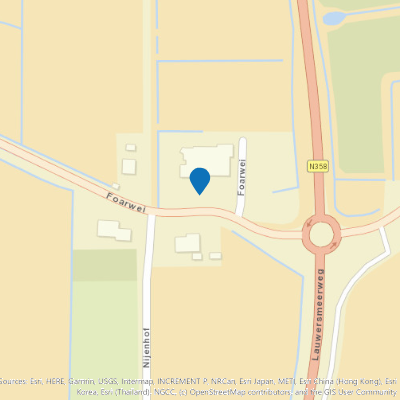Location
193 to 224 of 981 results
-
Bootverhuur de Granaet
Bootverhuur de Granaet Dokkum
Dokkum
from your location
-
Gastenverblijf Lânlibben
Gastenverblijf Lânlibben Lioessens
Lioessens
from your location
-
Salonboot De Nieuwe Liefde
Salonboot De Nieuwe Liefde Leeuwarden
Leeuwarden
from your location
-
Goddeloze Tolhuis
Goddeloze Tolhuis Broeksterwâld
Broeksterwâld
from your location
-
The bombing of Terherne lock
The bombing of Terherne lock
On 11 November 1944, pilots of the Royal Canadian Air Force, based at Welschap airfield near Eindhoven, were ordered to bomb the lock at Terherne in two groups. The reason for the bombardment of Terherne lock was to restrict (German) transport movements. The lock complex was situated on the main shipping route from Germany via Groningen to the Randstad, along which the Germans transported goods and military equipment.
After the railway strike in September had already disrupted rail transport considerably, actions against shipping traffic followed in the months thereafter. The southern part of the country may have been liberated, but fierce battles were still to be fought in the other parts.
Such was the case on that 11th November just after nine o'clock in the morning when the two groups of Hawker Typhoon fighter-bombers took off shortly after each other from Eindhoven for their mission. Around 10:00, the lock at Terherne was bombed from the north for the first time and then again around 10:30.
The consequences were huge for the people living on the lock. The wives of both lock keepers, a one-year-old baby and a German soldier were killed. Also, pilot John Gordon Fraser's aircraft was damaged to such extent that he had to make an emergency landing at St. Johannesga. Although the bombing resulted in the northern passageway being deactivated and no longer usable, the southern passageway remained open and could still be used.
Today, a boathouse for the State yacht of the province of Friesland has been built over the southern passage. A new building, that serves as a guest house for the province, was put up on the site of the lock keeper's house on the south side.
A monument has been erected on the northern pier in memory of those who perished at the lock. This monument was unveiled on 10 November 1985 by Hattum Hoekstra, son of 1st lock keeper Wiemer and Tietje Hoekstra. Since then, the commemoration of the dead in Terherne has always taken place at the old lock, and the children of primary school 'It Kampke' have adopted the monument.
 Terherne
Terherne
from your location
-
-
Lauwersland Cafe Restaurant Partycentrum
Lauwersland Cafe Restaurant Partycentrum Oudwoude / Kollum
Oudwoude / Kollum
from your location
-
Kloosterkapel Sibrandahûs
Kloosterkapel Sibrandahûs Sibrandahûs
Sibrandahûs
from your location
-
B&B 't Strunerke
B&B 't Strunerke Augustinusga
Augustinusga
from your location
-
Grutte Pier Brewery
Grutte Pier Brewery Wyns
Wyns
from your location
-
Kaasboerderij De Marlannen
Kaasboerderij De Marlannen Jouswier
Jouswier
from your location
-
Leeuwarden (Ljouwert)
Leeuwarden (Ljouwert) Leeuwarden
Leeuwarden
from your location
-
Oer de Wiel
Oer de Wiel Veenwouden
Veenwouden
from your location
-
Koudum - Wolvetinte - Uitkijkplatform
Koudum - Wolvetinte - Uitkijkplatform It Heidenskip
It Heidenskip
from your location
-
Bed & Breakfast It Keallehûs
Bed & Breakfast It Keallehûs Oentsjerk
Oentsjerk
from your location
-
Zeilschip Middelsee
Zeilschip Middelsee Engwierum
Engwierum
from your location
-
De Feroaring
De Feroaring Oudwoude
Oudwoude
from your location
-
Antoniuskerk Surhuizum
Antoniuskerk Surhuizum Surhuizum
Surhuizum
from your location
-
Buitenpost (Bûtenpost)
Buitenpost (Bûtenpost) Buitenpost
Buitenpost
from your location
-
Kunstwerk Heilige Grond
Kunstwerk Heilige Grond Burgum
Burgum
from your location
-
Groepsaccommodatie kleastermar
Groepsaccommodatie kleastermar Eastermar
Eastermar
from your location
-
Seventy evacuees from Arnhem and Limburg
Seventy evacuees from Arnhem and Limburg
The grave monument in Gytsjerkwas erected in memory of Maria v/d Heuij. Maria was one of seventy evacuees from Arnhem and Limburg who arrived in Gytsjerk on 22 January 1945. Maria died a day later, just a few months old. The harsh conditions during the trip had proved fatal to her. Maria did not live to see the liberation. Fortunately, many of the other evacuees with whom she undertook the journey did.
Symbolism
The monument's spiritual father, artist Klaas Bokma, chose two carts because this was the means of transport often used by evacuees. The four withered trees symbolise death. The cross is not only a symbol of the Christian faith, but also a reminder of the sacrifice made by war victims for a life of freedom.
The oldest pupils of Ichtus and Thrimwalda primary schools take care of this monument.
 Gytsjerk
Gytsjerk
from your location
-
-
Het Raadsel van de Wadden
Het Raadsel van de Wadden Anjum
Anjum
from your location
-
Vlieland - Dodemansbol - Vogelkijkhut
Vlieland - Dodemansbol - Vogelkijkhut Oost-Vlieland
Oost-Vlieland
from your location
-
Buwepleats - tweepersoonsappartement
Buwepleats - tweepersoonsappartement Drogeham
Drogeham
from your location
-
Nieuwebildtzijl (Nije-Syl)
Nieuwebildtzijl (Nije-Syl) Nieuwebildtzijl
Nieuwebildtzijl
from your location
-
Theetuin Kleine-Lijn
Theetuin Kleine-Lijn Blije
Blije
from your location
-
Veerpont Hin en Wer (Eernewoude)
Veerpont Hin en Wer (Eernewoude) Eernewoude
Eernewoude
from your location
-
Camperpark 'It Tún-Hûs'
Camperpark 'It Tún-Hûs' Anjum
Anjum
from your location
-
Boerderij naast de kerk
Boerderij naast de kerk Ryptsjerk
Ryptsjerk
from your location
-
Alexanderkerk Rinsumageast
Alexanderkerk Rinsumageast Rinsumageast
Rinsumageast
from your location
-
Waterspeelplaats de Kletspoat
Waterspeelplaats de Kletspoat Eastermar
Eastermar
from your location
-
11Fountains Dokkum
11Fountains Dokkum Dokkum
Dokkum
from your location


